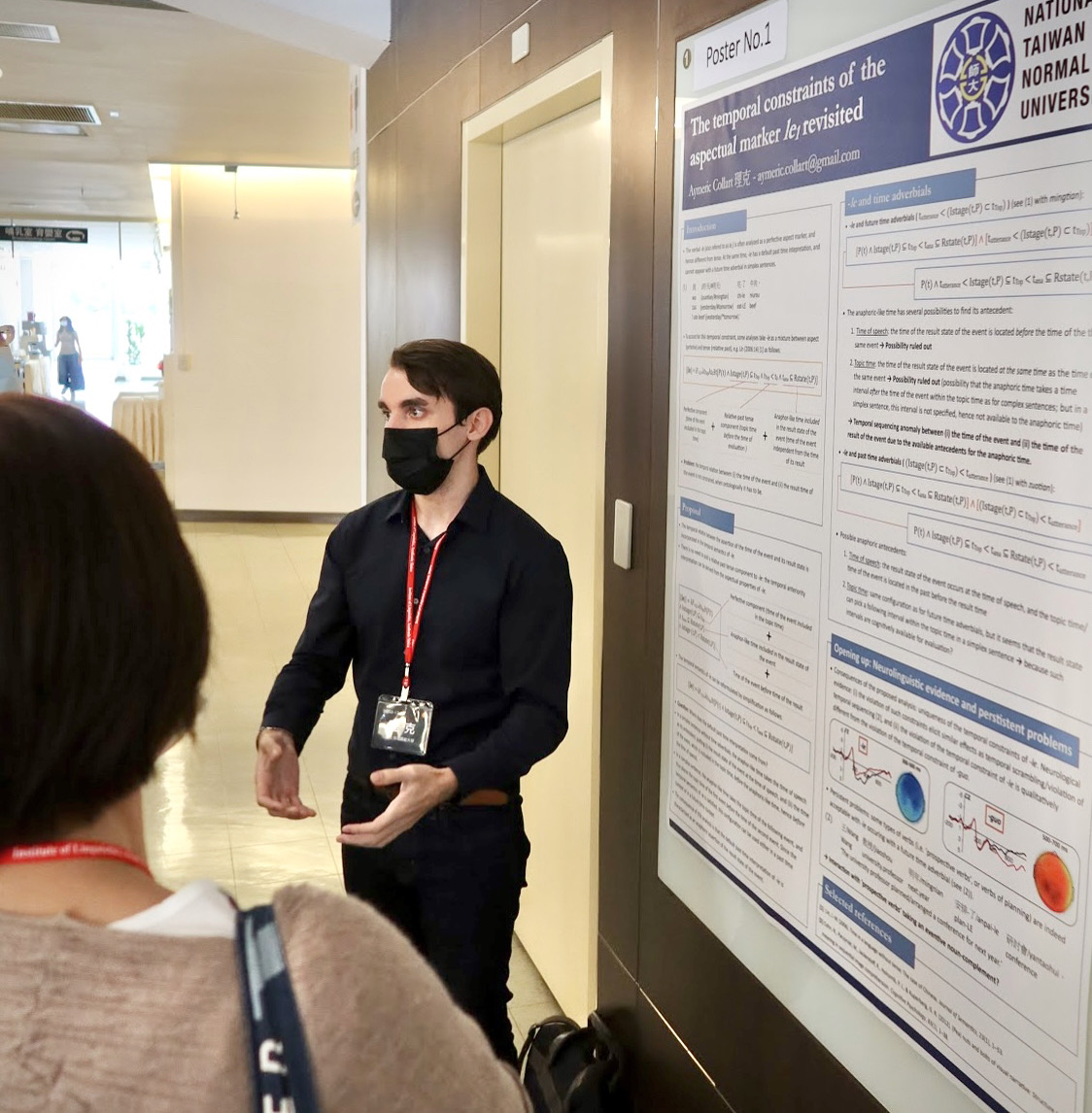Temporal reference in Mandarin Chinese and Taiwan Mandarin: Syntax and semantics, corpus and experiments
Page under construction
One of my main interests touches upon the question of the expression of time reference in Mandarin Chinese, which is often characterized as being a tenseless language. I aim to use corpus data as well as experimental (behavioral and neuroimaging) data to investigate how aspect and modal markers relate to the expression of time reference. In addition, I am also investigating markers found in several varieties of Mandarin Chinese, such as Taiwan Mandarin.
Parts of my research focusing on this topic can be found below:
📓 Journal articles
The mechanisms underlying the processing of the temporal reference of a sentence are still unexplored. Most of the previous psycholinguistic studies used the temporal concord violation between deictic time adverbs and tense marking on the verb to investigate this issue. They found that processing past tense marking is more difficult than non-past tense, indicated by lower accuracy rates and/or longer reaction time. However, it is not clear whether this complexity is due to tense marking or the temporal reference it denotes. This paper examines this issue with a judgment acceptability experiment in Taiwan Mandarin, which is analyzed as a tenseless language. The two modal auxiliary verbs you and hui were placed after deictic past time adverbs (grammatical with you but not with hui) and deictic future time adverbs (grammatical with hui but not with you). The temporal concord violation of the auxiliary verb you led to higher acceptability rates but longer reaction time than hui, reflecting higher processing difficulties. This paper argues that these complexities are due to the existential-assertive meaning of you, which interplays with the meaning of the event described by the verb rendering the situation more or less likely to occur in the future. The computation of the temporal concord of hui, displaying a future sense meaning, is more straightforward and therefore easier to process. This suggests that the mechanisms responsible for temporal reference processing are of different nature depending on the semantics of the temporal marker in the sentence.
The verb you ‘to have’ in standard Mandarin is typically followed by a noun. You can also take a VP as its complement (‘you + VP’) in several varieties of Mandarin. However, the function associated with it is still under debate: ‘you + VP’ has been analyzed as expressing past tense, perfective aspect, perfect aspect, or realis mood. This paper assesses these analyses by conducting a corpus-based investigation of ‘you + VP’ on the PTT platform and by looking at different morphosyntactic environments in which it is used. The data favor analyzing ‘you + VP’ as expressing an assertive modality meaning (the situation is considered true in the real world by the speaker). This analysis corroborates with the high frequency of ‘you + VP’ in assertive environments (e.g., after factual verbs in embedded clauses, with attitudinal adverbs of truth value, among others). Conversely, taking ‘you + VP’ as indicating past tense or perfective aspect is challenged by the present data, and the perfect aspect analysis cannot explain all the environments in which ‘you + VP’ is used. This paper provides new insights regarding the morphosyntactic use of ‘you + VP’ and sheds light on the meaning this construction encodes.
Reference to the time of an event can be encoded through various devices in language. While the neural processing of time reference in tense languages has been explored through tense inflection, relatively little is known about such processing through aspect in a tenseless language. The current study investigated how Mandarin speakers process perfective aspect markers -le and -guo, which are usually related to past time. Through the manipulation of the (dis)agreement between time adverbs and perfective markers, the results revealed that when co-occurring with a future/incongruent time adverb, compared with a past/congruent one, -le induced an early anterior negativity, while -guo triggered a P600. These distinct ERP patterns suggest that there is no unitary mechanism underlying perfectives in Mandarin, and that aspect modulates the relation of an event to time reference in a tenseless language, just like what tense inflection does in a tense language.
🗣 Selected conference presentations
Planning or not planning: Interplay between future time adverb and aspect markers/modal construction in (Taiwan) Mandarin. (Collart, 2023)The temporal constraints of le1 revisited. (Collart, 2020)
When time is a fact: A semantic and time-relational analysis of ‘you + VP’ in Taiwan Mandarin. (Collart, 2018)
